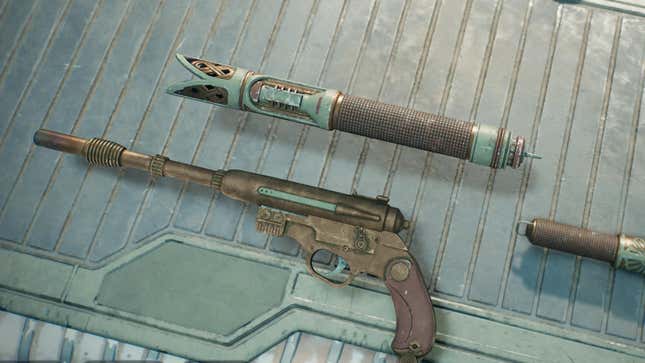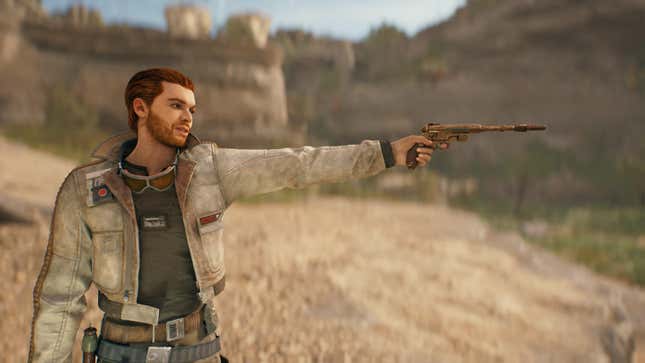Last week, my partner beat Star Wars Jedi: Survivor. I haven’t finished Fallen Order yet, so I watched a good chunk of the sequel next to him on the couch. But about two-thirds into the campaign, he put a PS5 DualSense controller in my hand and urged me to build my own lightsaber.
That half hour I spent playing around with the game’s extensive customization was an incredibly satisfying gaming experience, unlike anything I’ve experienced in any other Star Wars game before it. It’s a huge testament to Respawn’s dedication to delivering one of the best Star Wars games of all time.
Although you may fall in love with Jedi: Survivor because of its endless opportunities to serve obsceneIt is perfect mix of all eras of Star WarsIt is “Last good save” mechanic that prevents you from messing up too muchor the simple fact that it’s a very, very good game, I fell in love with his hyper-touch lightsaber, blaster, and BD-1 customization mechanics. So enamored, in fact, that I had to contact Respawn and find out the process behind creating Star Wars Jedi: Survivor’s extensive and hugely rewarding customization.
Look how pretty she is!Image: Respawn/Kotaku
Hanging out at Jedi: Survivor’s Workbench
So far into Jedi: Survivor, my partner has unlocked a pretty impressive collection of color schemes and gear components – so much so, in fact, that I’m immediately overwhelmed. What feels like a light tap of the joystick startles me, as several lightsaber parts pass through the center of the screen. “Okay, that’s a bit confusing,” warns my partner. I look at him, my eyes begging for help. “I use the crossguard stance, you can see that in the top right corner. But when I split it into two sabers for dual wielding, the left end is where a beam comes out, the right end is the other. My eyes tell him that didn’t help. “Just messing with it,” he insists.
I start on the far left: The 36,000°F beam of light that will emanate from the handle. I shift a color, because I want it to be golden, and I realize with joy that the buzz emanating from the light beam has changed in pitch. “This was also a game-specific design feature in Jedi: Fallen Order, but it was much more subtle…we wanted the sounds per color to be even more special, so we tried to make the difference much more obvious so people notice right away,” Oscar Coen, lead sound designer for Jedi: Survivor, told Kotaku via email.)
“We’ve always had the UI concept of floating lightsaber parts in our back pocket; while this allowed you to get closer to each part, there was a concern that players couldn’t see much more than four other parts, let alone their entire collection. – Jordan DeVries, Lead UX/UI Designer
After playing with the color of the blade, I move on to the emitter, where the blade will emanate from; it stands out from the rest of the lightsaber with a satisfying sound. I scan through my options, settling on the Hunter transmitter, which sounds strong but decidedly feminine, almost elvish. I paint it a light, metallic green, like matcha.

Image: Respawn / Kotaku
I move on to the other components, adjusting the angle of the crossguard, replacing its male silver components with parts that appear to be from the High Republic era of this universe. I can customize every inch of the weapon, from the switch that will draw the blade to the bottom of the hilt. I make sure the rest of the lightsaber is a mix of lightly worn gold metal and the same matcha green. It is undeniably beautiful. I wish I could have it in real life. I put down the controller, satisfied. “No, you still have to do your blaster and BD-1,” my partner reminds me.
Of course, they all have to match, so I give my blaster and bot the same earthy, feminine touch. When I’m done, the three of them are resting, shining on the workbench, looking like they belong to a handsome but deadly Jedi. The process of customizing all my weapons was so satisfying that I start over from the beginning. I don’t need to play yet.

Image: Respawn / Kotaku
Respawn Jedi: Survivor Customization Process
Achieving tactility and readability with Jedi: Survivor’s weapon and bot customization was a crucial part of Respawn’s development process. After the success of Fallen Order, the team noticed how popular social media posts featuring specific versions of lightsabers were and knew they “had to deliver that experience” in the sequel, according to the lead UX designer. /IX Jordan DeVries.
“Due to the significant increase in categories and types of parts, our original UI concepts focused on something more like the Doma’s Shop experience, with a larger, top-down overview. level of your lightsaber and a grid of all your collected parts—in early testing, players wanted to see their entire collection in a tangible way, instead of the more abstract icons of Jedi: Fallen Order,” he explained. “We’ve always had the UI concept of floating lightsaber parts in our back pocket; while this allowed you to get closer to each part, there was a concern that players couldn’t see much more than four other parts, not to mention their entire collection.
However, they went ahead and decided to stick with the idea of floating lightsaber parts that you could piece together bit by bit. “The trade-off was definitely worth it,” DeVries said. “Being able to ignite the lightsaber on the bench itself also went a long way in keeping the experience tactile. And when combined with the skillful movement of our animators and the sound effects of each piece sitting together, as well as the hands-on engineering from our 3D modeling team, the resulting experience is something we are incredibly proud of.
But there’s even more going on behind the scenes to make sure the experience feels like you’re, indeed, a Jedi using the Force to swap lightsaber parts.
“I wanted to make sure that the player never waits for an animation to end or a part to fall into place, when swapping a part or navigating to a different category,” said technical designer Michael Wong. . “To achieve this, we mix traditional static animation with code-driven movement. For each input the player presses, an animation plays on an invisible skeleton of the lightsaber, which is used as a guide for the code to move the individual parts in their place.This allows the workbench to react reactively to the whims of the player.
The Respawn team clearly went to great lengths to ensure that Jedi: Survivor’s lightsaber, BD-1, and blaster customization made it look like you were actually a mighty Jedi in the process of tinkering on his workbench – and it’s worth it. I haven’t even started my own reading of the acclaimed sequel, but I can’t help but think about what it felt like to build my own saber, how closest that was to the workshop The edge of the galaxy (I’m not paying to go out there and build this thing). When you make a Star Wars game, you can’t skimp on the little things, and the workbench and all of its tiny components have a huge impact on the magical feel of Jedi: Survivor.
.
Article source https://kotaku.com/jedi-survivor-lightsaber-designs-customization-respawn-1850476252

